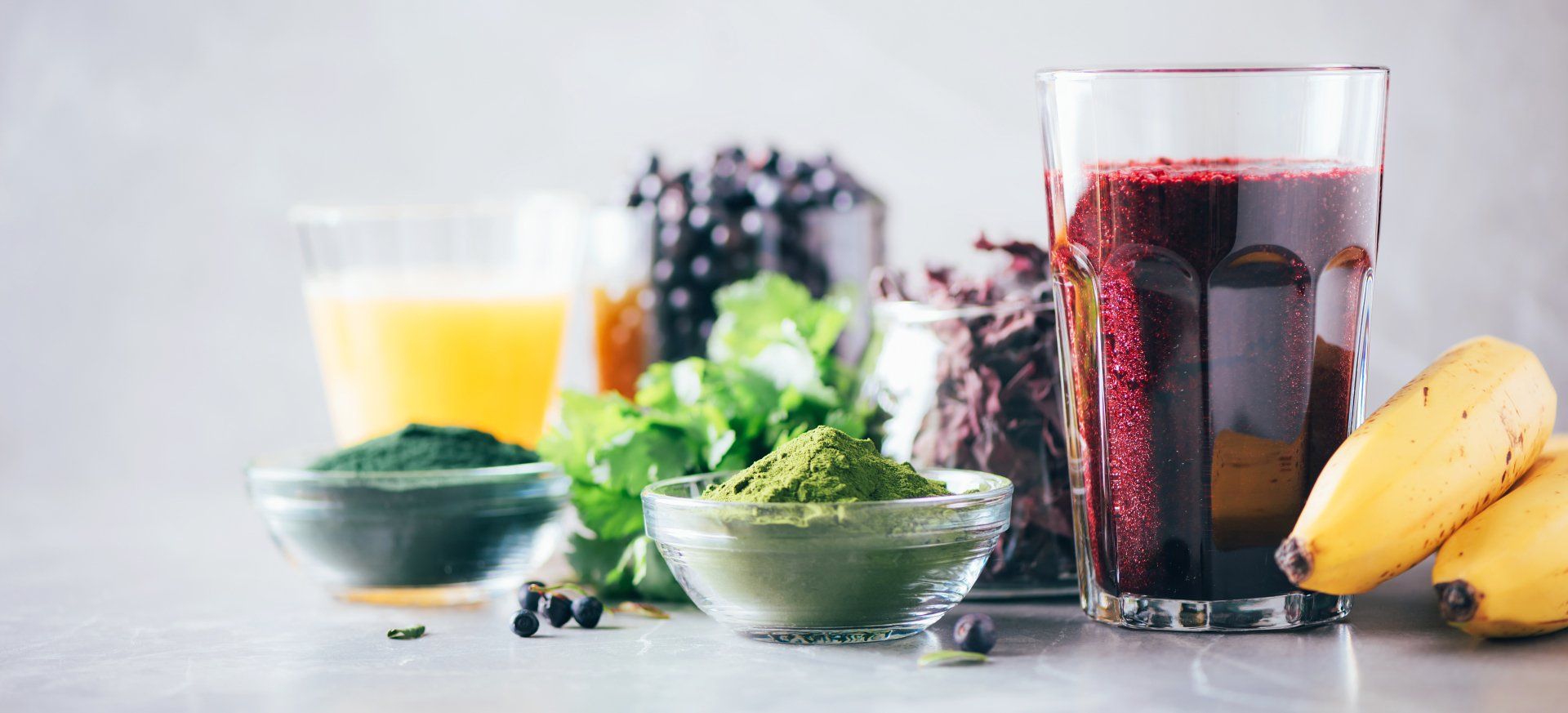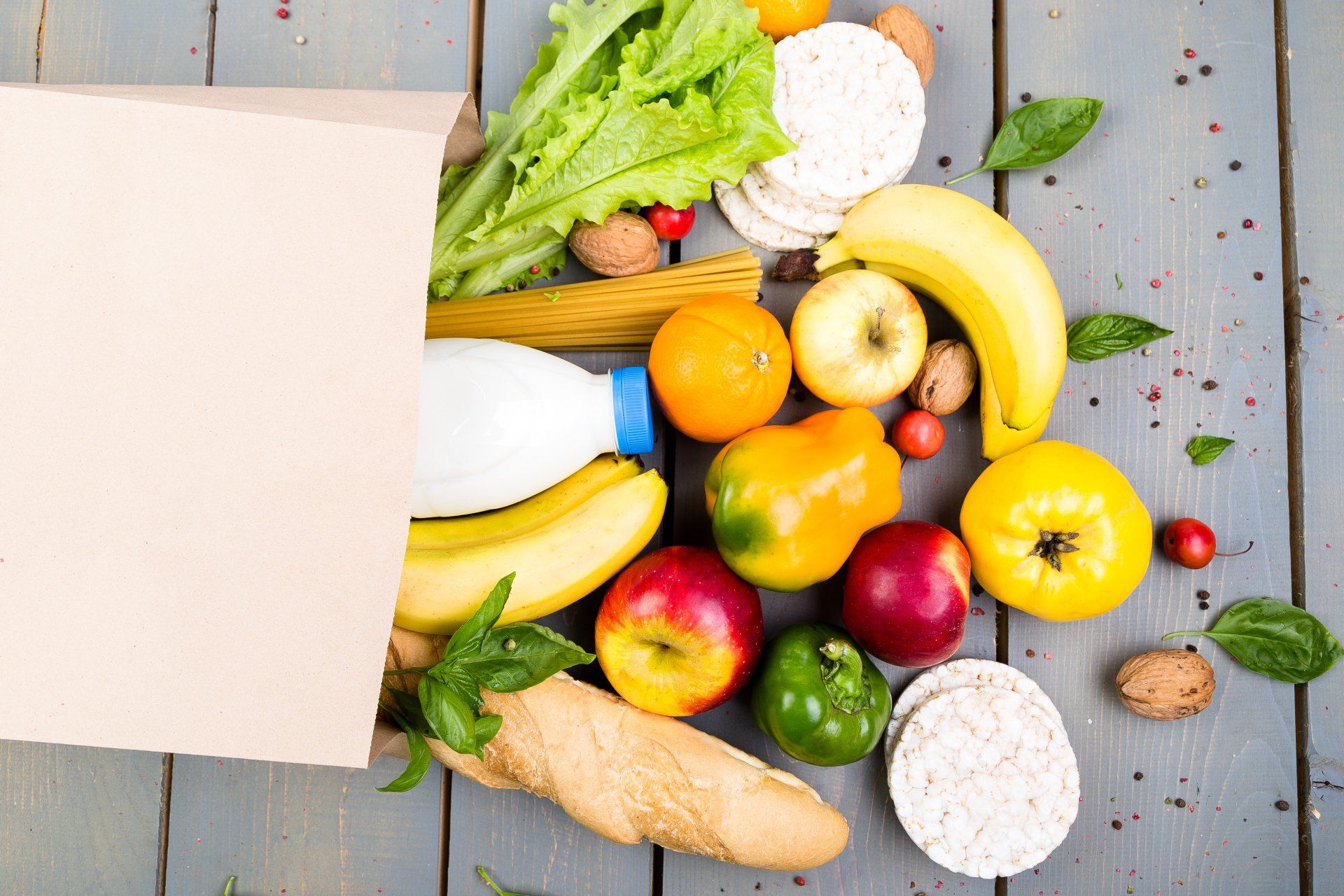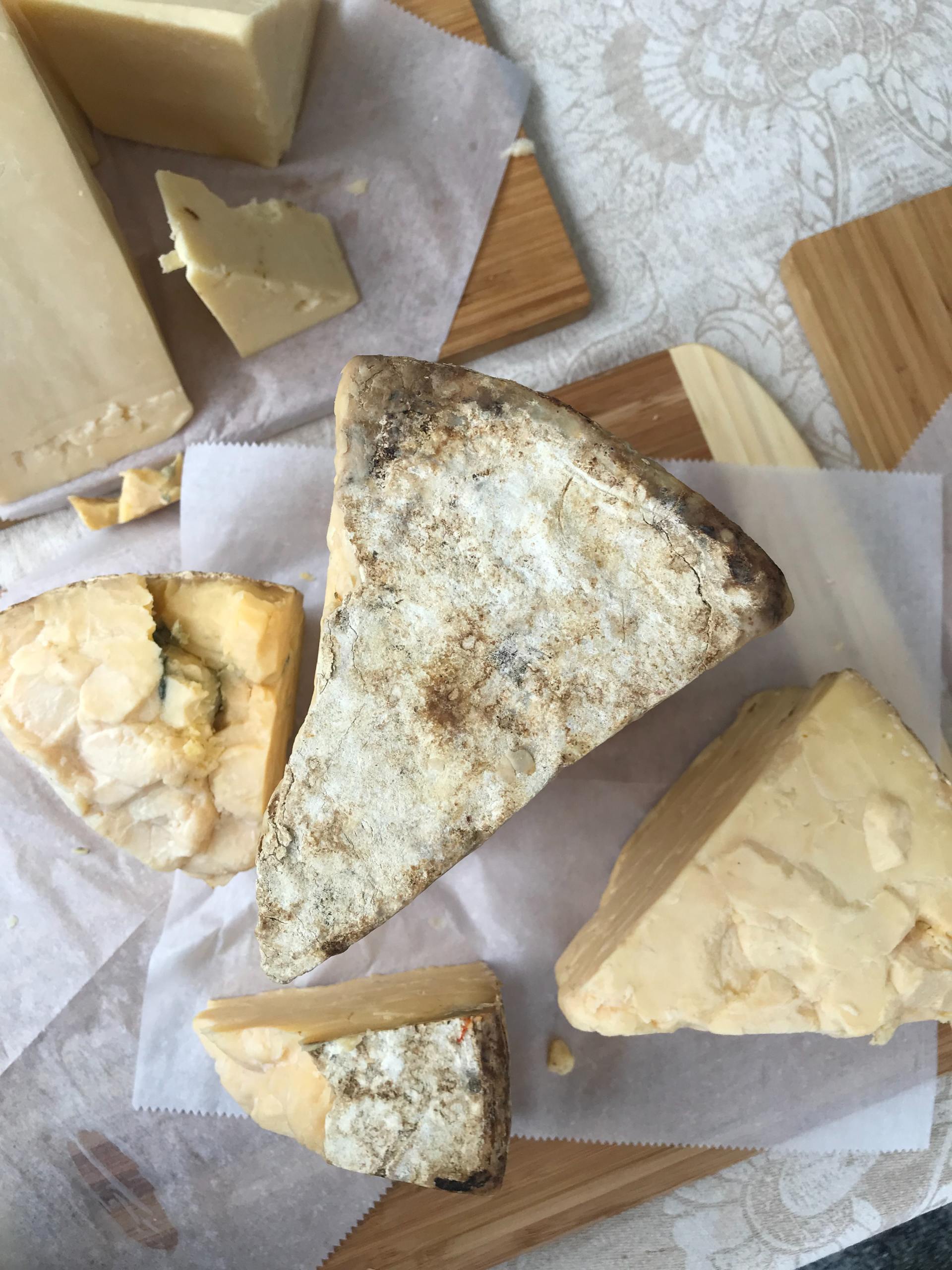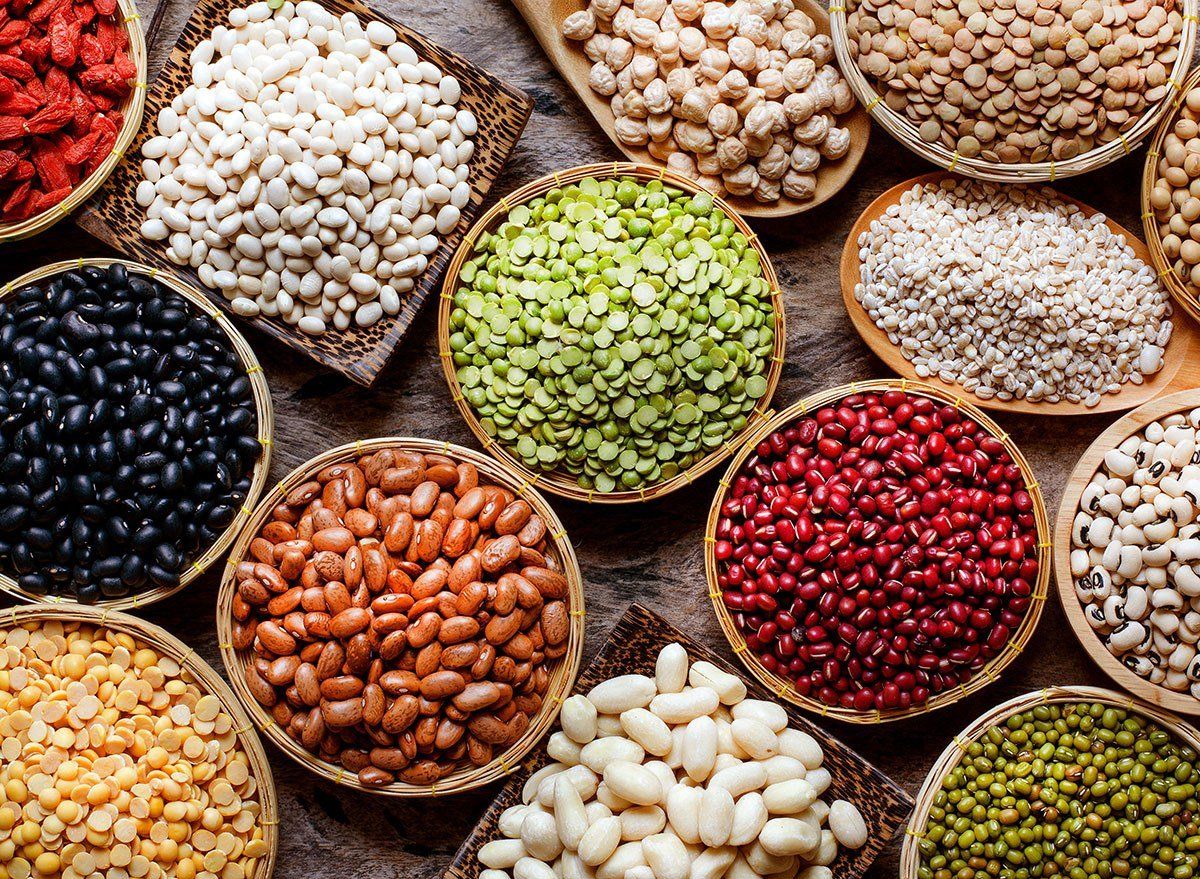My Blog
Everything Health, Wellness, Recipes and More!

Ninja. Breville. Omega. Vitamix. Cuisinart. Oster. NutriBullet. The coveted real estate on your counter deserves only the best appliances. Chances are, you own a blender or juicer; and, if not, then one of them is probably on your birthday wish list. A hot topic, and sometimes the cause of debate, is: Which is better? Juicing or blending? The main difference between the two is FIBER. Most Americans get 11g of fiber daily; and, only eat about 10-20 varieties of fruits and vegetables on a weekly basis. This is about 1/3 of the recommended intake. As a point of comparison, your ancestors typically consumed over 100+ grams of fiber from over 60 varieties of plants. No one can deny the incredible benefit of increasing your dietary intake of both soluble and insoluble fiber. And there are tons of dietary fiber – so many that they are not even all identified, but the benefits are clear: • Fiber feeds the microbes in our gut with prebiotics which in turn creates a healthy gut biome and boosts immune activity while staving off disease • Fiber lowers the risk of heart disease • Fiber lowers the risk of certain cancers • Fiber lessens cravings and enhances weight loss • Fiber promotes healthier elimination of waste products from your body • Fiber increases usually follows a diversified nutrient profile (e.g. if you are eating more fiber, you are likely eating more veggies, fruits, beans or legumes!) That said, eating the recommended 6-12 cups of veggies can be a challenge for even the most attentive clean eaters. That’s where blending comes into play. BLENDING: Blenders make smoothies, nut butters, nut milks, and soups with ease while keeping all the fibrous content of the ingredients intact. This way, you get 100% of a food’s content, while adding variety to how you consume your meals. And while it is true that chewing your food will enhance satiety, for some, blending becomes the easiest way to bolster the number of nutrient dense foods get consumed while increasing overall fiber intake. In contrast, juicers eliminate the fiber, but pack a different kind of nutritional punch. So yay. You can make a smoothie with frozen berries and get extra spinach or spirulina in there and not even taste it. But how frequently would you blend broccoli stems or zucchini? How about beets, carrots, celery or cucumber? JUICING: One obvious benefit to juicing is that you may expose yourself to an array of fruits or vegetable that may not have made your main plate – or at least not in as high a quantity. Juicing creates a high yield of nutrient-packed deliciousness in a way that doesn’t provide so much filling bulk as fibrous smoothies. In addition, juicing breaks down the cell walls of the vegetables, fruits, and herbs to make the nutrients within them highly bioavailable for your cells to ingest. That means you get a power-packed beverage that can aid in alkalizing and healing your body on a cellular level. Then, there are certain juice combinations used for therapeutic purposes – like celery juice for increasing hydrochloric acid levels to aid in digestion, or cabbage juices to help with digestive conditions like IBS. Have fruit fear? Don’t. No one has ever gotten diabetes or ended up a hospital's “I ate too many fruits and vegetables” wing. Don’t believe how powerful it can be? Watch the Super Juice Me documentary to see how powerful it can be. Personally, I both juice AND blend. My Ninja gets the most mileage for making daily smoothies and smoothie bowls in its single serving cup; but also has attachments that I frequently I use when I am blending larger quantities, making soups, or mixing vegan muffin ingredients. My Retro masticating juicer is no slouch either. It gets plenty of use for making celery juice and other green juices. For me, juicing is like a fast-track to boosted energy levels, reduced inflammation, improved digestion and more radiant, clear skin. Check out my recipes page for my favorite juice and smoothie recipes; and, check out my best picks for juicers and blenders if your counter has open real estate.

In your ongoing quest for better health or weight loss, have you ever said, “I know what I need to be doing…I just have to do it?” If you have, you wouldn’t be alone. But let’s quantify that. If someone asked what it is you “should be” doing, how would you define that? Do you believe you “should be” following a general method of eating like Keto, Paleo, Vegan, or Carnivore? Or do you believe in a more specific diet like Zone, South Beach, Whole30, Atkins or HCG? Perhaps you have specific behaviors you believe you should adopt like “don’t eat grains,” “avoid processed food,” “eliminate sugar,” “eat less, move more,” or “eat low carb.” Maybe you expand your philosophy to include eating methods like intermittent fasting, having 1 “cheat” meal per week, or not eating after 7pm. Listen, I don’t judge. I have a niece whose philosophy is, “if it used to have a spinal cord, I will not eat it…” And as a good Aunt, all I do is Google a little more at Thanksgiving to be sure I know what that list contains. Hmmm…fish have bones but do they even have spinal cords? Maybe your “right way to eat” is a mish-mash of ideas derived from fitness magazine articles, Weight Watchers meetings, conversations with fellow gym members, Dr. Oz shows, or health and diet books. Whatever the case, it is likely you have unknowingly created your own food philosophy – a personal theory about how to eat in order to obtain your optimal level of health or weight loss goal. You may or may not even be fully aware that you have one. It may be a philosophy you regard as a goal you will always strive for – but either way, it exists. You may even seem like the authority on it when someone asks you a question, because on certain topics regarding food, you are bound to have some strong opinions. So my follow up questions are likely obvious. Where do you get it- this philosophy of yours? Is it based in science? Is it based on your experience? Is it based on foods you like to eat or believe you can’t live without? And perhaps the most important question: is it truly the best plan for you? I would argue that everyone would benefit from having a philosophy that has real science to back it up. Why? Because if you are following a road map, you may want to know where you’ll end up. HOW TO START: STEP 1: Assess what you believe now. Don’t judge yourself. Just take an honest look at what you believe, why you believe it, and how that belief came to be. Maybe you’ve never thought it through before. Write it down on paper. STEP 2: Challenge it. If you believe in keto for weight loss because so many people you know have lost weight this way, is this enough? When looking it up on Google or reading an article or book, did you also find the real science to find out how it could also harm you? As a nutritionist for over 20 years, I have done this on several occasions. When you follow science, things evolve. When you aim for optimal wellness, you personally evolve. And sometimes, it has been a challenge to admit to myself that beliefs I held for years may not stand up to current truths that are indisputable. For example, 20 years ago, I used to tout the benefits of dairy like yogurt or cottage cheese as a good source of protein, but now fully understand the impact that dairy has on systemic inflammation, growth of cancers, and contribution to conditions like GI distress, acne, and more. But to hold onto an old philosophy would take a big ego, and I’m willing to admit when I am wrong. So we evolve. And so do our philosophies. STEP 3: Decide what’s important to you. Do you want to be thin at any cost – even if it means you put yourself at risk for disease? Or do you want to be thin, fit AND healthy? Once you clarify this, you will be open to modifying your current philosophy. STEP 4: Work out a new philosophy . This may be just a place to start that’s better than where you came from. For example, If you never eat vegetables and are eating fast food multiple times per week out of convenience but your philosophy has been, “I just need to eat well and exercise” then quantify it. What does “eat well” mean? Could we agree that more vegetables would be helpful? Could you start with a target of 2 veggies and 2 fruits per day? Could you walk for 5-10 minutes a day instead of trying to hit the gym hard on day 1? Your first new philosophy could simply be: “Eating vegetables and fruits will enhance my health – I aim to hit 2 of each every day as a jumping off point.” If you’ve always believed in Keto only to find out it can be cancer causing and give you a propensity long term of cardiac distress, what will you replace it with? (Hint: look up WFPB eating or watch Forks Over Knives). STEP 5: Allow yourself to evolve. I will tell you that my philosophy at the time of writing this blog is simple. I believe that a whole food, plant-based diet is one that will provide the most nutrition to support longevity, protection against disease, and weight management . I don’t believe in fad diets. I also believe that while EVERYONE can benefit from adopting a WFPB meal plan, there is a continuum on the path to change. I didn’t come to this belief overnight and wouldn’t expect my clients, or even my family, to either. I don’t even comply 100% yet. It doesn’t have to be all or nothing. It can be all or SOMETHING. Where is the common ground? Vegetables and fruits = good. Processed foods = bad. Animal foods raise propensity for cancer. Carbs are not the enemy unless they are in the shape of a muffin. Dairy is inflammatory. Hydration is paramount and you may be dehydrated Exercise carries immense health benefits Etcetera. My philosophy doesn’t have to be your philosophy, but I encourage you to learn. Keep learning. Ask questions. Your philosophy may be taking you down a path to poorer health, hormonal imbalance, and disease but you didn’t even realize it. It may be time to take a closer look - because before today, you may not have even known you had a FOOD PHILOSOPHY.

I had a lapse last night. Stressed from moving my son into college I found myself at a party with no clean food in sight. Fully unprepared, I caved. Cheese is my weakness. The Brie. It got me. It’s OK. Thanks for asking. I’m back on the bus today, but it made me think of everyone else who may share my cheese addiction or have compliance issues when they make decisions to stop eating dairy, but find it hard to follow through. What is it about cheese that makes it so dang addictive? Three words: SALT. FAT. CASOMORPHINE. Fat, salt, and sugar are the usual suspects when it comes to our food addictions. Our neurological pathways change once we’ve had a taste. There’s a reason why you pass your food of choice – pizza, M&M’s, cheese, chips, ice cream – multiple times, but then ultimately give in. When did it start? It may have happened to you at your first birthday party. You’ve all seen it. Mom forced chocolate cake into your mouth while Grandma clapped for you. And that was it. Your virgin palate got exposed to fat and sugar, your brain’s pleasure centers lit up as if you’d been given cocaine, your neurological pathways were forever altered, and the clapping further reinforced a pull to sugar that you probably still battle today. Thanks Grandma. But that aside, cheese has a special breed of neurotoxin that not only causes addiction, but also inflames the body and creates a histamine response. It’s called CASOMORPHINE. So while I’d love to lay on a bed of Gouda while someone sprinkles goat cheese on me (yes- my love of cheese is deep), I understand why. It’s basically a drug. And because of this, I have to continually find substitutions in my diet where cheese used to be, and also not have it laying around. It makes sense. Casomorphine helps a baby calf mellow out when nursing from mom. It's nature's way of saying, “Yeah - you like that? Come back at the next feeding time little one...” Since cows don’t pull babies out of their cribs at feeding times and put on soft soothing music while getting them to latch, Mother Nature gave cows a little edge to get their babies coming back: (1) animal instinct and (2) a drug-like substance in their milk to keep them coming back for more: a la, casomorphine. And here we are, the only species who drinks the milk of another animal after being weaned from our own mothers - eating cheese and consuming dairy at a higher rate in the USA than any other nation. And what do we get for it? We get a concentrated version of casomorphine in our dairy making it uber addictive. But that’s not all. We also get a full array of hormones needed to build a several hundred-pound cow, higher igF levels that spur cancer, a non-absorbable form of calcium (no you don’t need dairy to build strong bones), plus higher levels of inflammation, acidity, and histamine in our bodies. Yay us! Spread it, sprinkle it, melt it, cube it. Cheese. I get it. But it’s not meant for you. It’s not good for you. It’s inflammatory. It creates a histamine response. It contributes to high cholesterol levels. It promotes acne. It will impede your weight loss progress. And it will put a hold on you like a drug, only it’s legal in all states and disguised in the wrappings of a cracker. How do you beat the addiction? Well, if you go cold turkey, expect to feel a little withdrawal both physically and emotionally. What will you sprinkle on your salad? How will you make a lettuce wrap or sandwich without it? But you’ll live. Longer, I might add. Know that eventually that you will lose your flavor for it, and there are many great substitutions that have a cheese-like taste. Nutritional yeast and cheese sauces made with cashew or other nuts are a great starting point to create viable substitutions. If you don’t feel strong enough to go cold-turkey, cut it way down. For the love of God, stop drinking milk. • Replace cow’s milk and creamer with plant-based milks like almond, oat, cashew, or rice. • Eliminate all other cow cheese and switch to goat cheese which is slightly easier to digest. • Use crumbles or shreds on occasion versus blocks or sliced cheese because a little will go a long way. Then, while you are cutting down, try new recipes. Dairy-free spinach-artichoke dip. Cheese-free flatbreads. Spread avocado on a sandwich or wrap instead of cheese. Use spices and herbs to flavor foods. Once you get over your physical addiction, you may just get addicted to your clear skin, slimmer waistline, improved cholesterol levels, and knowledge that in the end, it is really only the baby cows that needed the dairy after all. For non-dairy recipes, visit my website at www.aprilritchotte.com





